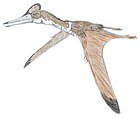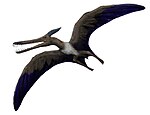Eurolimnornis: Difference between revisions
Adding local short description: "Genus of pterodactyloid pterosaur from the Early Cretaceous period", overriding Wikidata description "genus of reptiles (fossil)" (Shortdesc helper) |
m discontinued portal |
||
| (3 intermediate revisions by 2 users not shown) | |||
| Line 1: | Line 1: | ||
{{ |
{{Short description|Genus of pterodactyloid pterosaur from the Early Cretaceous}} |
||
{{Italic title}} |
{{Italic title}} |
||
{{speciesbox |
{{speciesbox |
||
| Line 11: | Line 11: | ||
}} |
}} |
||
'''''Eurolimnornis''''' is the name given to a [[monotypic]] [[genus]] of [[pterosaur]]s from the [[Early Cretaceous]]. The only known species ''E. corneti'' probably was originally identified as a primitive but essentially modern bird (or even as an early [[Neognathae|neognathe]] ancestral to the [[grebe]]s),<ref>'''Kessler''', E. & '''Jurcsák''', T. (1986): New contributions to the knowledge of the Lower Cretaceous bird remains from Cornet (Romania). ''Travaux du Musée d'Histoire Naturelle Grigore Antipa'' '''28''': 289–295.</ref> although alternative theories later suggested that it was a non-avialan [[theropod]] or pterosaur.<ref name=Benton>'''Benton''', M. J.; Cook, E.; Grigorescu, D.; Popa, E. & Tallódi, E. (1997): Dinosaurs and other tetrapods in an Early Cretaceous bauxite-filled fissure, northwestern Romania. ''Palaeogeography, Palaeoclimatology, Palaeoecology'' '''130''': 275-292. {{doi|10.1016/S0031-0182(96)00151-4}} [http://palaeo.gly.bris.ac.uk/Benton/reprints/1997Romania.pdf PDF fulltext] {{Webarchive|url=https://web.archive.org/web/20160411200050/http://palaeo.gly.bris.ac.uk/Benton/reprints/1997Romania.pdf |date=2016-04-11 }}</ref> The identification as a pterosaur was supported by a re-evaluation of the fossil remains published in 2012.<ref name=piksi>{{cite journal | author = Federico L. Agnolin and David Varricchio | year = 2012 | title = Systematic reinterpretation of ''Piksi barbarulna'' Varricchio, 2002 from the Two Medicine Formation (Upper Cretaceous) of Western USA (Montana) as a pterosaur rather than a bird | url = http://www.mnhn.fr/museum/foffice/science/science/DocScientifique/publications/presentation/publicationAP/ficheContenu.xsp?CONTENU_ID=4592&PARUTION_ID=2966&PUBLICATION_ID=21&idx=6&nav=listeParution | journal = Geodiversitas | volume = 34 | issue = 4 | pages = 883–894 | doi = 10.5252/g2012n4a10 | url-status = dead | archiveurl = https://archive. |
'''''Eurolimnornis''''' is the name given to a [[monotypic]] [[genus]] of [[pterosaur]]s from the [[Early Cretaceous]]. The only known species ''E. corneti'' probably was originally identified as a primitive but essentially modern bird (or even as an early [[Neognathae|neognathe]] ancestral to the [[grebe]]s),<ref>'''Kessler''', E. & '''Jurcsák''', T. (1986): New contributions to the knowledge of the Lower Cretaceous bird remains from Cornet (Romania). ''Travaux du Musée d'Histoire Naturelle Grigore Antipa'' '''28''': 289–295.</ref> although alternative theories later suggested that it was a non-avialan [[theropod]] or pterosaur.<ref name=Benton>'''Benton''', M. J.; Cook, E.; Grigorescu, D.; Popa, E. & Tallódi, E. (1997): Dinosaurs and other tetrapods in an Early Cretaceous bauxite-filled fissure, northwestern Romania. ''Palaeogeography, Palaeoclimatology, Palaeoecology'' '''130''': 275-292. {{doi|10.1016/S0031-0182(96)00151-4}} [http://palaeo.gly.bris.ac.uk/Benton/reprints/1997Romania.pdf PDF fulltext] {{Webarchive|url=https://web.archive.org/web/20160411200050/http://palaeo.gly.bris.ac.uk/Benton/reprints/1997Romania.pdf |date=2016-04-11 }}</ref> The identification as a pterosaur was supported by a re-evaluation of the fossil remains published in 2012.<ref name=piksi>{{cite journal | author = Federico L. Agnolin and David Varricchio | year = 2012 | title = Systematic reinterpretation of ''Piksi barbarulna'' Varricchio, 2002 from the Two Medicine Formation (Upper Cretaceous) of Western USA (Montana) as a pterosaur rather than a bird | url = http://www.mnhn.fr/museum/foffice/science/science/DocScientifique/publications/presentation/publicationAP/ficheContenu.xsp?CONTENU_ID=4592&PARUTION_ID=2966&PUBLICATION_ID=21&idx=6&nav=listeParution | journal = Geodiversitas | volume = 34 | issue = 4 | pages = 883–894 | doi = 10.5252/g2012n4a10 | url-status = dead | archiveurl = https://archive.today/20130107012637/http://www.mnhn.fr/museum/foffice/science/science/DocScientifique/publications/presentation/publicationAP/ficheContenu.xsp?CONTENU_ID=4592&PARUTION_ID=2966&PUBLICATION_ID=21&idx=6&nav=listeParution | archivedate = 2013-01-07 }}</ref> |
||
The holotype and only material known to date ([[Muzeul Ţării Crişurilor|MTCO-P]] 7896) is a [[Anatomical terms of location#Proximal and distal|distal]] fragment of the right [[humerus]], which was at first ascribed to the same species as the specimen of ''[[Palaeocursornis|Palaeocursornis corneti]]'', a possible synonym also originally identified as a bird.<ref>'''Bock''', Walter J. & '''Bühler''', Paul (1996): Nomenclature of Cretaceous birds from Romania. ''Cretaceous Research'' '''17''': 509–514. [http://www.geo.edu.ro/sgr/mod/downloads/PDF/Bock-KRes-1996.pdf PDF fulltext] {{Webarchive|url=https://web.archive.org/web/20160303191623/http://www.geo.edu.ro/sgr/mod/downloads/PDF/Bock-KRes-1996.pdf |date=2016-03-03 }}</ref><ref name=piksi/> |
The holotype and only material known to date ([[Muzeul Ţării Crişurilor|MTCO-P]] 7896) is a [[Anatomical terms of location#Proximal and distal|distal]] fragment of the right [[humerus]], which was at first ascribed to the same species as the specimen of ''[[Palaeocursornis|Palaeocursornis corneti]]'', a possible synonym also originally identified as a bird.<ref>'''Bock''', Walter J. & '''Bühler''', Paul (1996): Nomenclature of Cretaceous birds from Romania. ''Cretaceous Research'' '''17''': 509–514. [http://www.geo.edu.ro/sgr/mod/downloads/PDF/Bock-KRes-1996.pdf PDF fulltext] {{Webarchive|url=https://web.archive.org/web/20160303191623/http://www.geo.edu.ro/sgr/mod/downloads/PDF/Bock-KRes-1996.pdf |date=2016-03-03 }}</ref><ref name=piksi/> |
||
| Line 25: | Line 25: | ||
{{Pterosauria|M.}} |
{{Pterosauria|M.}} |
||
{{Taxonbar|from=Q2110679}} |
{{Taxonbar|from=Q2110679}} |
||
{{Portal bar|Paleontology|Romania}} |
|||
[[Category:Pterodactyloids]] |
[[Category:Pterodactyloids]] |
||
Latest revision as of 14:03, 11 February 2024
| Eurolimnornis Temporal range: Early Cretaceous,
~ | |
|---|---|
| Scientific classification | |
| Domain: | Eukaryota |
| Kingdom: | Animalia |
| Phylum: | Chordata |
| Order: | †Pterosauria |
| Suborder: | †Pterodactyloidea |
| Family: | †Eurolimnornithidae Kessler & Jurcsák, 1986 |
| Genus: | †Eurolimnornis Kessler & Jurcsák, 1986 |
| Species: | †E. corneti
|
| Binomial name | |
| †Eurolimnornis corneti Kessler & Jurcsák, 1986
| |
Eurolimnornis is the name given to a monotypic genus of pterosaurs from the Early Cretaceous. The only known species E. corneti probably was originally identified as a primitive but essentially modern bird (or even as an early neognathe ancestral to the grebes),[1] although alternative theories later suggested that it was a non-avialan theropod or pterosaur.[2] The identification as a pterosaur was supported by a re-evaluation of the fossil remains published in 2012.[3]
The holotype and only material known to date (MTCO-P 7896) is a distal fragment of the right humerus, which was at first ascribed to the same species as the specimen of Palaeocursornis corneti, a possible synonym also originally identified as a bird.[4][3]
The remains were found in Berriasian deposits (around 143 mya) at Cornet near Oradea, Romania. Eurolimnornis occurred on what was then an archipelago of volcanic and coral islands towards the east of the Piemont-Liguria Ocean. Its habitat was hilly, karstic terrain with numerous freshwater and/or brackish rivers, lakes and swamps. As this archipelago lay around 35°N latitude in a warmer, wetter climate than exists today, it was roughly similar to today's Caribbean or Indonesia.[2]
See also
[edit]References
[edit]- ^ Kessler, E. & Jurcsák, T. (1986): New contributions to the knowledge of the Lower Cretaceous bird remains from Cornet (Romania). Travaux du Musée d'Histoire Naturelle Grigore Antipa 28: 289–295.
- ^ a b Benton, M. J.; Cook, E.; Grigorescu, D.; Popa, E. & Tallódi, E. (1997): Dinosaurs and other tetrapods in an Early Cretaceous bauxite-filled fissure, northwestern Romania. Palaeogeography, Palaeoclimatology, Palaeoecology 130: 275-292. doi:10.1016/S0031-0182(96)00151-4 PDF fulltext Archived 2016-04-11 at the Wayback Machine
- ^ a b Federico L. Agnolin and David Varricchio (2012). "Systematic reinterpretation of Piksi barbarulna Varricchio, 2002 from the Two Medicine Formation (Upper Cretaceous) of Western USA (Montana) as a pterosaur rather than a bird". Geodiversitas. 34 (4): 883–894. doi:10.5252/g2012n4a10. Archived from the original on 2013-01-07.
- ^ Bock, Walter J. & Bühler, Paul (1996): Nomenclature of Cretaceous birds from Romania. Cretaceous Research 17: 509–514. PDF fulltext Archived 2016-03-03 at the Wayback Machine













